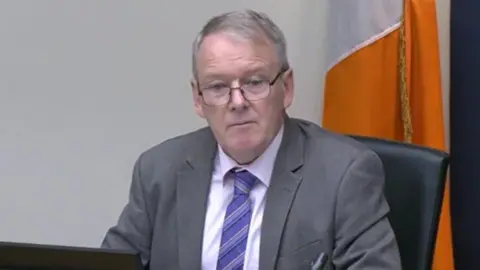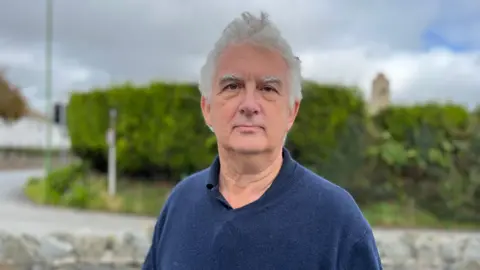McDonald says buck stops with her over handling of issues
 PA MediaSinn Féin president Mary Lou McDonald says the "buck stops with her" over the party's handling of Brian Stanley's resignationAny criminal complaint brought to Sinn Féin about Brian Stanley would have been brought to gardaí (Irish police), Mary Lou McDonald has said.
PA MediaSinn Féin president Mary Lou McDonald says the "buck stops with her" over the party's handling of Brian Stanley's resignationAny criminal complaint brought to Sinn Féin about Brian Stanley would have been brought to gardaí (Irish police), Mary Lou McDonald has said.
The long-standing Laois TD (MP) resigned from Sinn Féin on Saturday night amid reports of complaints against him within the party.
Sinn Féin said the complaint and counterclaim have been referred to gardaí following the conclusion of an internal party process.
On Monday, the party's president said it is not for her to decide whether it goes further but said "the buck does stop" with her over Sinn Féin's handling of the issue as leader of the party.
In a statement, Sinn Féin said that Mr Stanley was advised to go to the gardaí when matters of concern were raised during a preliminary party inquiry into a complaint made against him.
However, a party spokesperson said Mr Stanley chose not to do this.
Speaking to Irish broadcaster RTÉ, McDonald said the initial complaint against Stanley was received on 2 August.
He was made aware on 3 August and rejected the allegation.
"Had the initial complaint been of a criminal nature, it would have gone straight to An Garda Síochána," said McDonald.
"In any event it was not, and in the course of the inquiries, a counter allegation was also made."
'Abundance of caution'"The initial process concluded; it was written up; it was sent to both parties for comment, for accuracy, and so on, as per good procedure," the Sinn Féin leader said.
"Both parties were to come back this morning on that matter; the report also went to the head of the disciplinary committee, and the Sinn Féin disciplinary process is supervised by a barrister, and it's at arm's length from the party itself."
McDonald said following Stanley's resignation, matters were handed to the party chair, and with an "abundance of caution", it was referred to police.
"I am not in a position to say whether or not the complaint or the counter allegation meet the standard for criminal investigation—that's not my job," McDonald added.
"But I am far happier that the complaint and counter allegation are now in the hands of the gardaí and they can do what they deem to be appropriate."
In a statement issued through his solicitor on Monday, Stanley said Sinn Féin should had referred a complaint to gardaí when he brought serious matters forward at a disciplinary panel on 11 September this year.
 OireachtasBrian Stanley is set to be replaced as chair of the Public Affairs Committee on MondayIrish broadcaster RTÉ has reported that he said McDonald has "stated correctly" that the complaint made against him is not of a criminal nature.
OireachtasBrian Stanley is set to be replaced as chair of the Public Affairs Committee on MondayIrish broadcaster RTÉ has reported that he said McDonald has "stated correctly" that the complaint made against him is not of a criminal nature.
But, he said claims from the party's leadership that his rights were protected throughout the process are "totally incorrect".
Stanley said the complaint against him was first made on 26 July, the first day of the nomination process for candidates seeking to run in the general election.
This differs from the date McDonald had given of 2 August.
"In my case this had the effect of preventing me of having any hope of contesting it as a Sinn Féin candidate for Laois," he said.
The Laois TD also said he had made McDonald aware of the complaint on 29 July, and claimed that she gave the "wrong information".
Procedures 'fair and robust'Stanley has previously said he was subjected to a process that resembled a "kangaroo court".
This was rejected by McDonald, who claimed his rights were protected and noted that he had a barrister and solicitor present at a disciplinary panel meeting.
The panel, who were overseeing the complaint, is headed by a barrister and two people who are long-standing party members as well as the party chair.
McDonald said this is standard procedure.
The party leader also confirmed that "at no stage" did she discuss the complaint with Stanley.
She added the party procedures are "fair and robust" as well as impartial.
"I am very conscious that, firstly, when a complaint is made, that it's taken seriously, that it's processed appropriately, that everybody's rights are respected and protected," McDonald added.
"Unfortunately, in this case, we find ourselves in a position where Deputy Stanley has walked away from the process."
Stanley is set to be replaced as the chair of the Oireachtas's (Irish parliament) Public Accounts Committee after his resignation from Sinn Féin.
'More questions than answers'Speaking to RTE on Monday, Taoiseach Simon Harris said: “Objectively today has resulted in more questions than answers.
"The latest statement by deputy Stanley clearly contradicts a number of things said by deputy Mcdonald.
“My position on this has been very clear, it is about the leader of Sinn Féin to honestly put all of the information out there because the issues are serious.
“It would be helpful if as much information as possible is put into the public domain," he added.
He highlighted the need to rule out “political point-scoring”.
Dáil debate on McMonagle referencesRegarding allegations that inappropriate text messages were sent by a party official to a 17 year-old in Northern Ireland, as first reported by the Independent, McDonald said it was referred to the Police Service of Northern Ireland (PSNI), and there was no investigation and no charge.
Meanwhile, a debate on child protection sparked by Sinn Féin's actions will take place in the Dáil (lower house of Irish parliament) on Tuesday.
Time has been set aside for all parties to discuss matters relating to two Sinn Féin press officers who gave references for former colleague Michael McMonagle who was facing child sex allegations.
In September, McMonagle admitted to a series of offences, including attempting to incite a child to engage in sexual activity.
He is due to be sentenced in the coming weeks.
Both press officers, Seán Mag Uidhir and Caolán McGinley, have since resigned.
On this, McDonald said she has instigated an overhaul of procedures in the party.
Sinn Féin have noted that members and representatives of other parties have given references for people accused of sex crimes, including the current Ceann Comhairle (Speaker) Seán Ó Fearghaíl.
"Mistakes were made, there was gross misconduct, behaviour fell beneath standards," McDonald added.
"Rules have been applied… I stand over the fact our rules apply to everybody.
"That's life. That's politics."

 View image in fullscreenA suspected oil slick off Coogee beach alongside a ‘tar ball’ that washed up on the beach in Sydney’s east earlier this week. Composite: Supplied/Randwick City CouncilThe four Randwick beaches were closed until further notice.
View image in fullscreenA suspected oil slick off Coogee beach alongside a ‘tar ball’ that washed up on the beach in Sydney’s east earlier this week. Composite: Supplied/Randwick City CouncilThe four Randwick beaches were closed until further notice. 0:36Coogee beach suspected oil slick: beachgoers warned after black balls wash ashore – videoThe EPA said until the clean-up was concluded “we advise against swimming and touching any balls that may have washed ashore in the identified areas”.
0:36Coogee beach suspected oil slick: beachgoers warned after black balls wash ashore – videoThe EPA said until the clean-up was concluded “we advise against swimming and touching any balls that may have washed ashore in the identified areas”. Channel Islands Air SearchThe search crew used thermal image cameras to capture the entire rescue operationThe body of a woman who died after falling from a cruise ship was located "very quickly", according to the head of the air search service.
Channel Islands Air SearchThe search crew used thermal image cameras to capture the entire rescue operationThe body of a woman who died after falling from a cruise ship was located "very quickly", according to the head of the air search service. John Fitzgerald heads up Channel Islands Air Search which is called out when people's lives are in dangerFollow BBC Guernsey on X (formerly Twitter) and Facebook. Follow BBC Jersey on X (formerly Twitter) and Facebook. Send your story ideas to
John Fitzgerald heads up Channel Islands Air Search which is called out when people's lives are in dangerFollow BBC Guernsey on X (formerly Twitter) and Facebook. Follow BBC Jersey on X (formerly Twitter) and Facebook. Send your story ideas to